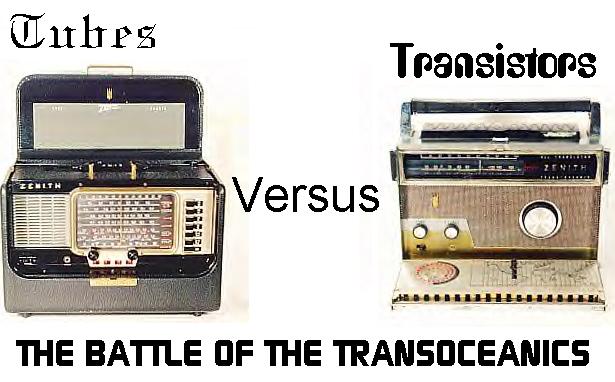

Representing the two types
Two types of Zenith TransOceanics were made, tube and transistor. I, owning a tube TransOceanic (model B-600) but previously not having a transistor TransOceanic, asked the folks of rec.antiques.radio+phono which type of TransOceanic was better, tube or transistor in the following areas: sensitivity, sound, and looks. I developed a yearn for a transistor TransOceanic after first writing this article. After various conversations on rec.antiques.radio+phono and the now-defunct TransOceanic mailing list, I acquired my very own transistor TransOceanic, a Royal 1000. I decided to add to the categories. When conducting the reception tests I performed, the B-600 was powered from AC, while the Royal 1000 was powered by a pair of 6V lantern batteries wired in series. For the sound test I powered the B-600 off my homemade battery pack and powered the the Royal 1000 with a 9V Radio Shack AC adapter (it puts out 11.25 volts under load, which is more than enough to get it playing). Here are the results:
Site Navigation
Sensitivity:
What others think: The transistor TransOceanics have better sensitivity than the tube models.
What I think: I compared the first three bands on both models (BC, 2-4MC and 4-9MC; I haven't had a chance to compare the other bands yet), and the Royal 1000 seems to have better sensitivity than the B-600.
Sound:
What others think: While the transistor TransOceanics are louder than the tube models, most owners think that the tube TranOceanics sound better than the transistor models due to the wooden case and larger speaker, although the transistor models do have respectable sound quality.
What I think: Instead of using an outside audio source, I decided to do a test using a BC radio station (WCCM [800KC] in Boston, which played nice old music). The audio coming from the B-600 was better sounding and louder than the Royal 1000.
Looks:
What others think: Almost all TransOceanic owners agree that the tube TransOceanics win the looks competition hands-down. Even though the solid-state models have a large amount of chrome, they don't really stand out among other transistor radios (with the exception of size).
What I think: Before I got a front door for my B-600, I couldn't really decide. Now that I have one, I can clearly see that my B-600 wins when it comes to looks. To me, the tube TransOceanics look better than the transistor TransOceanics. While the leatherette on my B-600 is not in the best condition, the heavily-pitted chrome on my Royal 1000 looks much worse. For a visual comparison, here are pictures of a B-600 tube TransOceanic (on the left) along with pictures of a Royal 1000 transistor TransOceanic (on the right) (pictures of my B-600 and my Royal 1000 sitting side-by-side will hopefully be coming later):
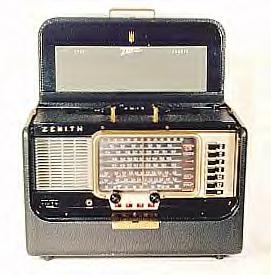
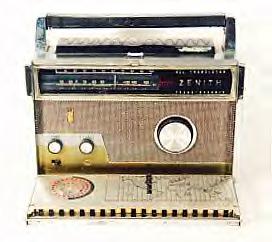
To most, black leatherette and brass looks better than leather and (usually pitted) chrome. Now, let's compare the rear inside views of the B-600 and the Royal 1000:
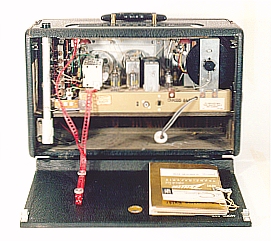
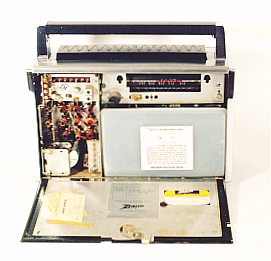
To most, a brass chassis with glass tubes beats steel chassis with tiny transistors (most of which in this photo are covered by the battery box). Still, there are some that think the transistor models look better. I myself prefer the tube models, although the transistor models look nice too. Of course, everyone is entitled to their own opinions.
-Adam
Peter Wieck of rec.antiques.radio+phono newsgroup adds the following comments:
"I have 'one-of-each' of the transistor T/Os, (althought precisely only one of
each type, not of each variation). I also have one of each type of tube T/O. I
find that the Royal D7000Y is the best of the bunch in reception, ease of use,
and station-holding. The R7000-1 (Taiwan) is almost as good, but to my taste
the additional bells & whistles add little.
Put head-to-head, the Royal 1000 and the 600 series are about alike in
performance and bandspread (deliberately, from Zenith's point of view). The
sound on the tube set is fractionally better than in the 1000, and with
batteries, the Royal weighs about the same as the 600 without, but at a much
reduced bulk. No FM, of course, but definitely a nifty radio. The 1000D adds a
weather band, useful to the yachtsman in its time.
The Royal 3000 adds FM, but is otherwise much as the 1000. The Royal 7000
series adds a BFO, the D7000Y adds a tuneable weather band. Both again useful
additions.
The R7000 series is as much a TransOceanic as the label on it. As apples and
oranges are definitely both fruits. But the radio is NOT of the same species as
its predicessors. Not that I am trashing it by any means, but if the one I have
had not literally fallen in my lap, I would not have gone out of my way to
acquire one. I will keep it as the 'capstone' to the line, but not for the same
reasons I keep the others."
TransOceanic images used by permission of Phil's Old Radios website,
http://antiqueradio.org/index.html, Copyright 1995-2000 (C) Philip I.
Nelson, all rights reserved.
Back to my TransOceanic page!
Back to my old radio page!
Back to the main page!